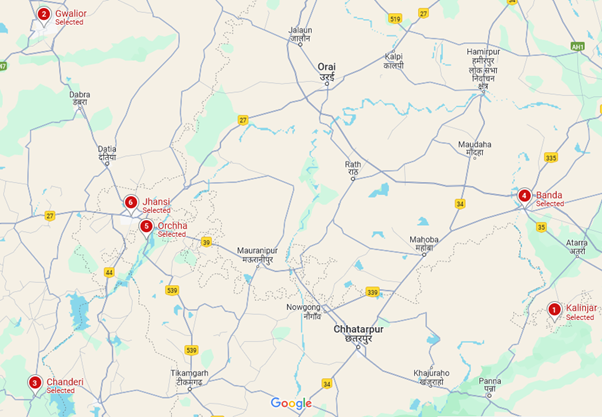Half the kingdom of Orchha’s Prithvi Singh was confiscated by the government. After Naropant rendered the Orchha town to dust, the king there moved to a new capital at Tehri fifty miles to the south. That principality lasted till independence. Naro Shankar took the Jhansi fort in his control and settled a city beneath it. He brought the people from Orchha there and settled them there. This became the later Jhansi principality. He also took many families there from the Deccan. Since the main road to enter the Ganga-Yamuna Doab passed through Jhansi, trade and commerce prospered and Jhansi city became wealthy. Jhansi’s name has later become indelibly linked to the history due to Rani Lakshmibai’s valour.
It would be worthwhile to note the Maratha officials at Jhansi after Naro Shankar.
- Mahadaji Govind (Kakirde?) – from 1756 to 1760.
- Baburao Konher – 1761-1765.
- Vishwasrao Lakshman 1766-1769.
- After this, Raghunath Hari Newalkar was a great warrior Subedar. He again arrested the king of Orchha and held him a prisoner atop Jhansi fort. Orchha was destroyed completely. The administration was carried ahead in the family of Raghunath Hari.
Nanasaheb sent Holkar and Shinde to obtain pending dues from Rajputana, instructing them to be stern with the Rathod ruler of Jodhpur, “Do not hold any kind of friendship towards Abhay Singh, threaten Jodhpur, take control of two to four important locations there, and earn money. Unless we display callousness, they won’t come to the negotiating table. Their emissaries have come here, but they do not pay much attention. Rathod is untrustworthy. Do not hold any affection or sympathy towards them and respond clearly.”
The Dussehra of 1741 was extremely successful for Nanasaheb Peshwa. On the Vijayadashmi of this year, Nanasaheb embarked on the campaign after seeking the blessings from the Chhatrapati and his revered mother. He spent the next one year in the north. He met Jaisingh, and acquired the grant-notifications for Malwa from the Badshah, or one can also say snatched them from the Badshah. He flew up to the eastern seas and helped settled down Raghuji there. After completing the religious pilgrimage at Kashi, Prayag, and Gaya along with his whole army, he turned back. He intended to finish off settling down the arrangement of Bundelkhand, and whatever big and small affairs there, and then return to homeland. However, at this time, Maharaj’s health deteriorated at Satara, and he was recalled immediately. Shahu was afraid, that Raghuji Bhosale’s affair would escalate similar to that of the Dabhades. Therefore, Shahu also recalled Raghuji urgently to meet him. Shahu’s fear, however, turned out to be misplaced. Bajirao was someone who would nurture the kingdom on the basis of his military prowess. Whereas Nanasaheb was exactly opposite, someone who would impress his opponents through his diplomatic manoeuvres to get his objectives accomplished, and who would arrest any kind of escalations. Therefore, he accomplished an unprecedented success in this long campaign by acquiring the Malwa grant-notifications, came back to Pune towards the end of June 1743 to meet his revered mother, and immediately proceeded to Satara for a meeting with Maharaj. There, Shahu brought about a lasting friendship between the Peshwa and Raghuji, and gave a fillip to the concept of the Maratha Confederacy. Maharaj’s health also had improved in the meanwhile.
Of course, Shinde and Holkar remained in Malwa encamped there. In that relation, Mahadoba had dispatched an instruction to the Peshwa as follows, “Every year, the moment the Narmada is crossed, the soldiers are bid farewell. This year, the Swami should not disband the army. Shinde and Holkar should be kept in Malwa up to the month of Ashwin. The Swami must have thought likewise, but just a suggestion made.” This way, Shinde and Holkar encamped in the north for the first time in year 1743.
To be continued…

